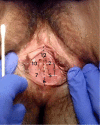Mucosal versus muscle pain sensitivity in provoked vestibulodynia
- PMID: 26316805
- PMCID: PMC4540214
- DOI: 10.2147/JPR.S85705
Mucosal versus muscle pain sensitivity in provoked vestibulodynia
Abstract
Background: An estimated 8.3%-16% of women experience vulvovaginal discomfort during their lifetime. Frequently these patients report provoked pain on contact or with attempted intercourse, commonly referred to as provoked vestibulodynia (PVD). Despite the burden of this condition, little is known about its potential etiologies including pelvic floor muscular dysfunction and mucosal components. This knowledge would be beneficial in developing targeted therapies including physical therapy.
Objective: To explore the relative contribution of mucosal versus muscle pain sensitivity on pain report from intercourse among women with PVD.
Design: In this proof of concept study, 54 women with PVD underwent a structured examination assessing mucosal and pelvic muscle sensitivity.
Methods: We examined three mucosal sites in the upper and lower vestibule. Patients were asked to rate their pain on cotton swab palpation of the mucosa using a 10-point visual analog scale. Muscle pain was assessed using transvaginal application of pressure on right and left puborectalis, and the perineal muscle complex. The Gracely pain scale (0-100) was used to assess the severity of pain with intercourse, with women rating the lowest, average, and highest pain levels; a 100 rating the highest level of pain.
Results: The lower vestibule's mucosa 5.81 (standard deviation =2.83) was significantly more sensitive than the upper vestibule 2.52 (standard deviation =2.6) (P<0.01) on exam. However, mucosal sensitivity was not associated with intercourse pain, while muscle sensitivity was moderately associated with both average and highest intensity of intercourse pain (r=-0.46, P=0.01 and r=-0.42, P=0.02), respectively.
Conclusion: This preliminary study suggests that mucosal measures alone may not sufficiently capture the spectrum of clinical pain report in women with PVD, which is consistent with the empirical success of physical therapy in this population.
Keywords: dyspareunia; pain sensitivity; pelvic floor muscle pain; pressure pain threshold; provoked vestibulodynia; vulvar pain; vulvodynia.
Figures




Similar articles
-
Relationship between nongenital tender point tenderness and intravaginal muscle pain intensity: ratings in women with provoked vestibulodynia and implications for treatment.Am J Obstet Gynecol. 2016 Dec;215(6):751.e1-751.e5. doi: 10.1016/j.ajog.2016.06.047. Epub 2016 Jul 1. Am J Obstet Gynecol. 2016. PMID: 27377821 Free PMC article.
-
Predictors of Mucosal and Muscle Pain in Vulvodynia: A Cross-Sectional Analysis From the National Vulvodynia Registry.J Pain. 2021 Feb;22(2):161-170. doi: 10.1016/j.jpain.2020.07.001. Epub 2020 Jul 14. J Pain. 2021. PMID: 32679255
-
Pelvic Floor Muscle Morphometry and Function in Women With Primary and Secondary Provoked Vestibulodynia.J Sex Med. 2018 Aug;15(8):1149-1157. doi: 10.1016/j.jsxm.2018.06.001. Epub 2018 Jul 20. J Sex Med. 2018. PMID: 30033191
-
Psychological Treatments for Provoked Vestibulodynia: Integration of Mindfulness-Based and Cognitive Behavioral Therapies.J Clin Psychol. 2016 Jul;72(7):637-50. doi: 10.1002/jclp.22286. Epub 2016 Mar 28. J Clin Psychol. 2016. PMID: 27019368 Review.
-
Active and Passive Components of Pelvic Floor Muscle Tone in Women with Provoked Vestibulodynia: A Perspective Based on a Review of the Literature.J Sex Med. 2015 Nov;12(11):2178-89. doi: 10.1111/jsm.13028. J Sex Med. 2015. PMID: 26745618 Review.
Cited by
-
Vestibular Anatomic Localization of Pain Sensitivity in Women with Insertional Dyspareunia: A Different Approach to Address the Variability of Painful Intercourse.J Clin Med. 2020 Jun 27;9(7):2023. doi: 10.3390/jcm9072023. J Clin Med. 2020. PMID: 32605092 Free PMC article.
-
Does Degree of Vulvar Sensitivity Predict Vulvodynia Characteristics and Prognosis?J Pain. 2017 Feb;18(2):113-123. doi: 10.1016/j.jpain.2016.10.006. Epub 2016 Oct 24. J Pain. 2017. PMID: 27789257 Free PMC article.
-
Vestibulodynia presentation is differentiated by the presence of additional chronic primary pain conditions.J Pain. 2025 Aug;33:105450. doi: 10.1016/j.jpain.2025.105450. Epub 2025 May 22. J Pain. 2025. PMID: 40412493
-
Recent advances in understanding provoked vestibulodynia.F1000Res. 2016 Oct 26;5:2581. doi: 10.12688/f1000research.9603.1. eCollection 2016. F1000Res. 2016. PMID: 27853523 Free PMC article. Review.
-
Pelvic floor examination in vulvodynia: VAMP protocol validation in correlation with central sensitization.Womens Health (Lond). 2025 Jan-Dec;21:17455057251338410. doi: 10.1177/17455057251338410. Epub 2025 Jul 1. Womens Health (Lond). 2025. PMID: 40590401 Free PMC article. Clinical Trial.
References
-
- Harlow BL, Stewart EG. A population-based assessment of chronic unexplained vulvar pain: have we underestimated the prevalence of vulvodynia? J Am Med Women’s Assoc. 2003;58(2):82–88. - PubMed
-
- Reed BD, Crawford S, Couper M, Cave C, Haefner HK. Pain at the vulvar vestibule: a web-based survey. J Low Genit Tract Dis. 2004;8(1):48–57. - PubMed
-
- Goetsch MF. Vulvar vestibulitis: prevalence and historic features in a general gynecologic practice population. Am J Obstet Gynecol. 1991;164(6 Pt 1):1609–1614. discussion 1614–1606. - PubMed
-
- Harlow BL, Wise LA, Stewart EG. Prevalence and predictors of chronic lower genital tract discomfort. Am J Obstet Gynecol. 2001;185(3):545–550. - PubMed
-
- Nunns D. Vulval pain syndromes. BJOG. 2000;107(10):1185–1193. - PubMed
Grants and funding
LinkOut - more resources
Full Text Sources

